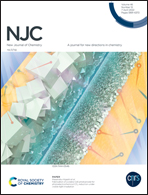Naphthalene-tagged highly stable and reusable luminescent metal–organic probes for selective and fast detection of 4-nitroaniline in water†
Abstract
In this paper, we report the synthesis, characterization, properties and application of four new Zn(II) and Cd(II)-based luminescent metal–organic probes, {[Zn(mbhna)(bpea)]}n (1), {[Cd(mbhna)(bpea)]}n (2), {[Zn(mbhna)(bpba)]·CH3OH·H2O}n (3) and {[Cd(mbhna)(bpba)]}n (4), composed of a commercially available bis(naphthalene)-based dicarboxylate (mbhna) acting as the luminescent tag. In addition to spectroscopic and compositional characterization of 1–4 by FTIR spectroscopy, elemental analysis, and EDX and elemental mapping, their surface morphology was analysed by FESEM and TEM. Their (dispersed in water) green emission (at 548 nm for 1 and 2, 551 nm for 3, and 547 nm for 4) established by fluorescence spectroscopy on excitation at 380 nm was further explored for the effect of different solvents on their emission intensities. Taking their emissive nature into account, 1–4 were utilised for the detection of harmful amines in water. These were found to recognise the presence of 4-nitroaniline (4-NA) in water with high efficiency (as low as 97 ppb) and selectivity. The ultrafast detection as well as paper strip detection of 4-NA by 1–4 and their recyclability have confirmed that these probes can be useful for real time applications.



 Please wait while we load your content...
Please wait while we load your content...